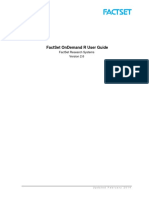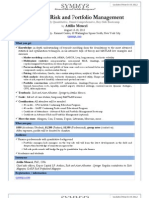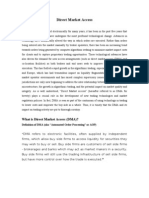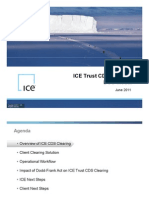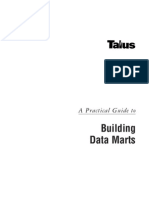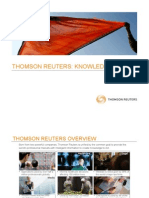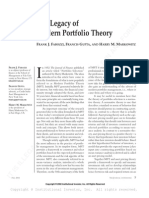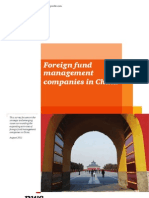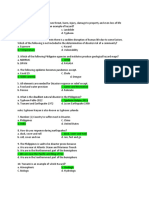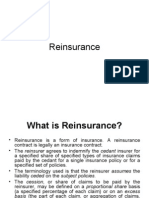Celent Buy Side Risk Impact Note
Celent Buy Side Risk Impact Note
Uploaded by
imnowhere62Copyright:
Available Formats
Celent Buy Side Risk Impact Note
Celent Buy Side Risk Impact Note
Uploaded by
imnowhere62Copyright
Available Formats
Share this document
Did you find this document useful?
Is this content inappropriate?
Copyright:
Available Formats
Celent Buy Side Risk Impact Note
Celent Buy Side Risk Impact Note
Uploaded by
imnowhere62Copyright:
Available Formats
BUY SIDE RISK MANAGEMENT
OILING THE SWAPS MACHINERY
Cubillas Ding
May 2014
CONTENTS
Executive Summary ............................................................................................................ 1
Structural Drivers Continue to Shape the Buy Side Business Agenda ............................... 2
Trend 1: Changing Investor Priorities and Multiasset Class Investing
Require Increased Sophistication .................................................................................... 2
Trend 2: Alternative Assets as a Path to Diversification and Resilience ......................... 4
Trend 3: Risk Factor-Based Approaches Continue to Rise ............................................ 5
Trend 4: Regulations Are Creating Uncertainty and Raising Barriers to Entry ............... 5
Trend 5: Imperative to Drive Efficiency, Manage Costs, and Increase Efficacies........... 7
Seeing the Full Picture of Operational Alpha ...................................................................... 8
Oiling the Swaps Machinery ............................................................................................ 8
Evolve Towards a Dynamic, Risk-Aligned Investment Lifecycle ..................................... 8
Raise the Bar Towards a Total Risk Governance Model ............................................ 10
Optimize Collateral Value Chains for Efficiency ............................................................ 11
Sharpen Analytical Capability to Navigate Evolving Swaps Product, Trading,
and Capital Economics .................................................................................................. 12
Looking Forward ............................................................................................................... 14
Leveraging Celents Expertise .......................................................................................... 15
Support for Financial Institutions ................................................................................... 15
Support for Vendors ...................................................................................................... 15
Related Celent Research .................................................................................................. 16
EXECUTIVE SUMMARY
The industry has come of age, and it needs to evolve and show the next level of maturity
in line with the degree of weight, influence, and risk that it poses to the financial stability
within the broader economy as a whole. Regulators are presently starting to perceive
investment managers as potentially a source of systemic risk and may therefore demand
higher levels of capital from the largest systematically important asset managers. This is
not yet reality but regulators may not be sitting on their laurels for long.
In the midst of growing regulator scrutiny and heightened investor expectations, buyside
firms will need to develop new capabilities in line with investment strategies that are more
diversified, defensive, and risk-transparent. Where relevant, firms will be required to
optimize their participation in the embryonic swaps trading and clearing ecosystem to
mitigate the potential drag on portfolios.
From an investors standpoint, in line with delivering to sophisticated mandates and
implementing clever investment ideas, firms will need to demonstrate sound operational
consistency to execute on those ideas. In this sense, in order to achieve financial alpha,
buyside firms will need to establish operational alpha. Celent recommends the pursuit of
the following levers:
Evolve towards a dynamic, risk-aligned investment lifecycle. The trend towards
industrialization of investment risk operations and technology enablement is no
longer a nice to have. Investors have become increasingly focused on ensuring
managers implement a strategy appropriate infrastructure. There is clear evidence
that investors are becoming intolerant of firms and products where there is poor risk
transparency, where investment processes are not easily explained, and where
sources of performance are not obvious.
Raise the bar towards a total risk governance model. In leading investment
firms, there are already concerted efforts driven top-down to achieve a total
governance of risk across portfolios and firmwide levels, and across financial and
nonfinancial risk. This is based on consistent, aligned, and coordinated activities and
information flows between internal front and middle office risk functions and
governance/oversight committees, as well as external investor and regulatory
stakeholders.
Optimize collateral value chains for efficiency. Firms must pursue collateral
management strategies that enable operational efficiency around margining
operations and enable collateral efficiency/optimization simultaneously in the front
line, with the aim of sourcing, placing, and managing the flow of appropriate collateral
across the firm.
Sharpen analytical capability to navigate evolving swaps product, trading, and
capital economics. In the near-term to midterm horizon, with new market
infrastructures for derivatives such as SEFs and CCPs changing the economics of
trading and imposing stringent margining requirements, the imperative to
systematically embed decision support measures to enable the front line portfolio
managers and traders to navigate strategic portfolio composition and rebalancing
decisions, and to incorporate considerations around collateral to decide on the most
capital-efficient routes to market for derivatives will be key.
C
h
a
p
t
e
r
:
S
t
r
u
c
t
u
r
a
l
D
r
i
v
e
r
s
C
o
n
t
i
n
u
e
t
o
S
h
a
p
e
t
h
e
B
u
y
S
i
d
e
B
u
s
i
n
e
s
s
A
g
e
n
d
a
2
STRUCTURAL DRIVERS CONTINUE TO SHAPE THE BUY
SIDE BUSINESS AGENDA
TREND 1: CHANGING INVESTOR PRIORITIES AND MULTIASSET CLASS
INVESTING REQUIRE INCREASED SOPHISTICATION
Following the fallout from the financial crisis, the continued search for yield in a low
interest rate, capital-constrained environment has pushed investors to demand not only a
level of capital protection but also predictable risk-aligned returns.
Requirements from different investor segments from defined benefit and defined
contribution pension funds, to insurers, high net worth individuals, endowments,
sovereign wealth funds, and retail investors continue to diverge in terms of allocating
assets and buying behaviors, based on a mix of different priorities, such as capital
preservation, absolute return objectives, tailored product/risk characteristics, and risk
factor diversification requirements, as well as criteria around liquidity, fees, transparency,
and risk governance.
Figure 1: Evolving Investor Priorities and Sophistication Differ Across Client Segments
Source: Principal Global Investors / CREATE-Research Survey 2013, Celent
In order to meet some these requirements for certainty and acceptable returns, asset
managers have moved towards broader asset classes, beyond equities and fixed
income, to provide higher levels of diversification while employing more sophisticated
investment strategies to limit downside risks and enhance returns. These multiasset
investment approaches aim to allow investors to achieve a targeted level of returns while
spreading the risk across asset classes such as real estate, commodities, hedge funds,
emerging markets, private equity, or cash. Here, the idea of investing across asset
classes in the face of financial uncertainty is also predicated on an ability to be able to
respond to near-term volatility and move investments to better-performing asset classes,
avoiding the risk of overexposure to a single asset class.
Investors are demanding more transparency and alignment between performance and
risk characteristics of the funds they are investing in. This also means that astute
investors are demanding risk-adjusted performance measures with increasing granularity
to show managers/funds that beat the market consistently over the longer run.
C
h
a
p
t
e
r
:
S
t
r
u
c
t
u
r
a
l
D
r
i
v
e
r
s
C
o
n
t
i
n
u
e
t
o
S
h
a
p
e
t
h
e
B
u
y
S
i
d
e
B
u
s
i
n
e
s
s
A
g
e
n
d
a
3
Figure 2: Evolving Investor Priorities, Structural Market Impact, and Complex Investment Strategies
Source: Celent
There are strong arguments for using both active and passive elements for different parts
of the portfolio. For instance, passive funds can be the best way to access large
companies on relatively efficient and liquid markets like the US stock market, where it is
particularly difficult to add value (i.e., it is hard to get an information advantage on a
particular company when there is a high concentration of analysts covering a single
stock). On the flip side, the argument runs that active funds add greater value in less
established, less liquid, or esoteric markets, such as those in emerging markets or
smaller companies. Even with ongoing deliberations around the merits and drawbacks of
alpha versus beta approaches, the majority of firms still look to blend both active and
passive investing within an overall portfolio.
Over the last few years, asset owner relationships with investment managers are
becoming more outcome-focused, based on absolute returns management rather than on
benchmark investing (like in the past). This reflects the long-term desire of asset owners
to design structurally oriented policy allocations around specific objectives, and this will
differ from investor to investor. Investor segments with more sophisticated requirements
and long-dated risks will demand multiasset composite products and/or balanced funds
across equities and fixed income, with a focus on alternatives supplemented by a
spectrum of investment and overlay strategies.
C
h
a
p
t
e
r
:
S
t
r
u
c
t
u
r
a
l
D
r
i
v
e
r
s
C
o
n
t
i
n
u
e
t
o
S
h
a
p
e
t
h
e
B
u
y
S
i
d
e
B
u
s
i
n
e
s
s
A
g
e
n
d
a
4
TREND 2: ALTERNATIVE ASSETS AS A PATH TO DIVERSIFICATION AND
RESILIENCE
From a market and business perspective, recent years have seen significant capital
poured into the alternatives segment of the market
1
, as well as alternatives-like portfolios
that have elements of structured investing, quantitative strategies, or bespoke investment
mandates.
As shown in Figure 3, some of the drivers of this rapid rise are the result of a buoyant
market environment. There has been an uptrend in both traditional funds and alternatives
in general, but we expect the share of alternative assets and strategies to continue to
grow faster, from its current 23% levels to hit around 10% in the next five years.
Figure 3: Alternative Assets Are a Focus in the Thrust Towards Diversification
Source: eVestment Alternative Fund Survey 2014, Morningstar, Strategic Insight, Cerulli, Celent analysis
There is also a broader dynamic at play: Institutional investors especially are switching to
a polarized strategy. On one end of the spectrum, they are investing in passive vehicles
(ETFs/indexed products) for low-cost and beta returns; on the other end, they are
investing in less liquid assets and alternatives to generate value-added alpha. In many
cases, alternatives have attracted a larger share of new money over the years, as
investors look to diversify from mainstream long-only bonds and equity investments.
The key takeaway here is that alternatives are already going mainstream, and could be
structurally embedded into asset owner portfolios to become a permanent fixture in terms
of allocation of assets.
1
We are employing the term alternatives in a loose way, to mean non-conventional portfolios or assets, which
have elements of structured investing, quantitative strategies, and/or bespoke characteristics, including hedge
funds and illiquid assets such as real estate, infrastructure, private equity, asset-backed investments, loan
funds, and so on.
C
h
a
p
t
e
r
:
S
t
r
u
c
t
u
r
a
l
D
r
i
v
e
r
s
C
o
n
t
i
n
u
e
t
o
S
h
a
p
e
t
h
e
B
u
y
S
i
d
e
B
u
s
i
n
e
s
s
A
g
e
n
d
a
5
TREND 3: RISK FACTOR-BASED APPROACHES CONTINUE TO RISE
The financial crisis uncovered fundamental weaknesses in conventional business models
and exposed a fragile paradigm in the investment management process where strategic
asset allocation is based on asset class diversification (rather than true risk
diversification). As the financial crisis events unfolded, many investors suffered
significantly larger losses than their measures of portfolio risk had told them they should.
Many actively managed portfolios failed to deliver the diversified alpha returns that they
had promised would partly offset market falls. To varying degrees, traditional asset
allocation techniques optimize portfolio exposure based on loose assumptions about
the risk, return, and correlation between asset classes (i.e., diversification across assets
is sought).
In many instances observed, what looked to be highly diversified portfolios had
correlated asset classes with high concentrations of underlying risk factors resulting in
the losses observed in investment vehicles which were previously considered safe.
Since the global financial crisis, investors insist on greater clarity and understanding into
the underlying risk factors that characterize asset class returns and the correlation
between assets. In response, the investment management industry is at an early stage of
moving from conventional strategic asset allocation based on asset class approaches to
encompassing risk factor-based frameworks.
Risk factor approaches are not new, but they have primarily been employed in equity
research. Progressively, emerging applications include the use of risk factors for
multiasset investing, enhanced performance transparency for governance and control,
and for setting a strategic benchmark.
In particular, pension funds, insurers, and endowment firms
2
are expanding their use of
risk factor-based frameworks for strategic portfolio allocation and construction, mandate
definition, and portfolio monitoring and control. In essence, this will enable a greater
transparency into the drivers of return rather than focusing on asset class (i.e., factor
allocation vs. asset allocation). This is especially pertinent in the context of longer-term
asset/liability risk management.
The idea of balancing risk factors, essentially diversifying across sources of risk, rather
than via asset classes per se, enables asset managers to build (and optimize) a more
diversified portfolio that performs more consistently in different environments according to
where each risk factor is active and prevalent. Done correctly, it also enables investors to
discern between rewarded and unrewarded risks, and therefore make decisions to take
on risks for which they can realistically be rewarded according to investment appetite in
an optimized manner.
TREND 4: REGULATIONS ARE CREATING UNCERTAINTY AND RAISING
BARRIERS TO ENTRY
Beyond changes in markets and investment paradigms, the impact of regulation and
structural trends on the financial services sector is creating operational challenges, but
also business opportunities for buy side firms. Regulatory themes around derivatives
market reforms, liquidity requirements, investor protection, conduct of business
standards, transparency reporting, and risk management are already adding to
overheads, and therefore requiring firms to develop sustainable operating models.
2
We are already seeing some leading global institutional investors, like CalPERS, CalSTRS, Canada Pension
Plan Investment Board, the Danish pension fund ATP, Alaska Permanent Fund Corporation, Norwegian
Government Pension Fund, and sovereign wealth funds of New Zealand be the most visible proponents of
risk factor-based approaches, although implementation is still in early stages. These are typically based on
factors such as real interest rate, realized inflation rate, expected inflation rate, volatility, and growth.
C
h
a
p
t
e
r
:
S
t
r
u
c
t
u
r
a
l
D
r
i
v
e
r
s
C
o
n
t
i
n
u
e
t
o
S
h
a
p
e
t
h
e
B
u
y
S
i
d
e
B
u
s
i
n
e
s
s
A
g
e
n
d
a
6
For example, Dodd-Frank and EMIR clearing mandates for OTC derivatives, Basel III and
Solvency II capital provisions, and UCITS, AiFMD, and MiFID II will change fee models,
increase operating overheads, increase standards for risk management practices, and
enlarge collateralization requirements for investment firms and the ecosystem of firms
that service the buy side, such as clearing brokers, clearing venues, asset servicing
agents, and collateral managers. European post-trade regulations like T2S and CSD will
also impact the entire value chain of their custodians and CSDs.
Figure 4: Market Changes Will Alter Derivatives Usage, Trade Dynamics, and Cost of Hedging
Source: Oliver Wyman, Morgan Stanley, Celent Buy Side Clearing and Collateralization Survey 2013
At the ground level, portfolio managers and traders face increased complexity and
tradeoffs in implementing derivatives and overlay strategies. Specifically, in the interim,
Dodd-Frank, EMIR, MiFID II, and Basel III regulations will alter dealer-client relationships
and how markets operate in a few ways.
First, the buy side will require access into more industrialized infrastructure with greater
electronification through SEFs and central clearing (not merely for derivatives but also for
areas such as cash fixed income trading).
Second, what it also means is that outside the largest investment firms, midtiers and
smaller boutiques will face a squeeze in terms of the cost and complexity of accessing
new products because of the need to implement collateralization infrastructures, as well
as having to open up channels to access liquidity facilities that are required to operate in
the new CCP and capital-heavy regimes.
Third, these structural changes will impact trading behavior and in some cases, constrain
investment strategies and asset allocation approaches. On this front, in our recent
surveys, buy side firms are re-evaluating relationships with dealer banks and the type of
products they are employing. Figure 4 (on the right-bottom) shows the directional
changes in the various products with interest rate swaps expected to exhibit the
biggest drop in trading volume, while swap futures and US Treasuries (and Treasury
futures) gain ground.
C
h
a
p
t
e
r
:
S
t
r
u
c
t
u
r
a
l
D
r
i
v
e
r
s
C
o
n
t
i
n
u
e
t
o
S
h
a
p
e
t
h
e
B
u
y
S
i
d
e
B
u
s
i
n
e
s
s
A
g
e
n
d
a
7
In essence, every piece of regulation carrying risk and transparency dimensions has
already raised the bar in terms of the breadth and granularity of risk reporting not only to
internal stakeholders but also to external constituents across the value chain of clients,
consultants, and regulators. Firms will no longer be able to neglect the imperative to
create efficiencies in how managers make investment decisions, manage risk, and
deliver to regulatory commitments. If left unmitigated, these changes could reduce
returns and eat into investment performance.
TREND 5: IMPERATIVE TO DRIVE EFFICIENCY, MANAGE COSTS, AND
INCREASE EFFICACIES
It remains critical for asset managers to adopt efficient business and operating models in
order to generate alpha and, at the same time, be operationally lean to sufficiently
counter downward pressures on risk-adjusted returns and management fees.
Furthermore, the change in investment approaches and how portfolios are constructed
will require upgrades to portfolio construction, risk management, and attribution systems
and will require firms to address operational limitations to handle multiple strategies
active, passive, quantitative, and blended.
C
h
a
p
t
e
r
:
S
e
e
i
n
g
t
h
e
F
u
l
l
P
i
c
t
u
r
e
o
f
O
p
e
r
a
t
i
o
n
a
l
A
l
p
h
a
8
1
SEEING THE FULL PICTURE OF OPERATIONAL ALPHA
OILING THE SWAPS MACHINERY
In the coming years, structural changes in client types, investment preferences, and the
shift in the industrys derivatives ecosystem will require firms to look at issues from a
systemic perspective, rather than in parts or in purely functional terms.
Figure 5 lays out an example of the spectrum of areas which investment firms must
contend with in order to be successful. These operational enablers are highlighted in
more detail in the following sections.
Figure 5: Achieving Change and Efficiency in the Swaps Processing Ecosystem (Buy Side View)
Source: Celent
EVOLVE TOWARDS A DYNAMIC, RISK-ALIGNED INVESTMENT LIFECYCLE
In most cases, the robustness and operational resiliency of investment and risk
operations should be tied to the level of risk associated with trading strategies, risk
velocity, liquidity, and other risk characteristics of a firm's investment and derivative
overlay strategies.
In recent years, investors have also become increasingly focused on ensuring managers
implement a strategy appropriate infrastructure. There is already clear evidence that
investors are becoming intolerant of products where there is poor transparency, where
risk is not clear, where investment processes are not easily explained, and where
sources of performance are not obvious. A robust and scalable operational infrastructure
is critical to appeal to quality investors. Not only do teams need to prove their ability to
C
h
a
p
t
e
r
:
S
e
e
i
n
g
t
h
e
F
u
l
l
P
i
c
t
u
r
e
o
f
O
p
e
r
a
t
i
o
n
a
l
A
l
p
h
a
9
generate stable alpha for their investors, they must also demonstrate strong operational
experience and tested business management skills.
3
From a portfolio and investment risk standpoint, demands from institutional investors will
require stronger operational, IT, and data alignment between investment workflows
(portfolio management, asset selection), and risk measurement and control. This requires
consistency in the investment process, with full participation (or at least a sufficient
degree of involvement) of the risk function in core investment decisions in effect,
embedding risk management in the investment workflows.
Figure 6: Risk-Aligned Investment Lifecycle
Source: Celent
From an operations and technology standpoint, broad requirements and implications for
portfolio and risk management activities include the following:
Centralization of investment book of records (IBOR) to create one version of the
truth.
Portfolio and risk systems having the full capabilities around risk factor analysis
across multiasset classes within an integrated framework.
Consistent multifactor models deployed across front and middle offices.
Flexible modeling platform, which can also support proprietary and third party model
development and governance for portfolio construction and optimization activities.
Fundamental changes to risk budgeting, mandate structuring, and performance
measurement away from an overriding focus on asset allocation to include risk factor
allocation.
Ability to simulate a variety of scenarios across business as usual macroeconomic
scenarios, extreme scenarios, or scenarios around selected risk factors in isolation.
3
From Deutsche Banks 2013 and 2014 Alternatives Survey: The most frequently cited factor for an operational
due diligence teams decision to veto an investment (i.e., to disqualify investment in a fund) is due to
insufficient operational/technology infrastructure (45%), followed by poor segregation of duties (42%), and
insufficient compliance policies and procedures (42%).
C
h
a
p
t
e
r
:
S
e
e
i
n
g
t
h
e
F
u
l
l
P
i
c
t
u
r
e
o
f
O
p
e
r
a
t
i
o
n
a
l
A
l
p
h
a
10
2
Attribution of risk between active and beta market risk.
Ability to use and manage cost-effective products to manage exposure to specific
risk factors (e.g., alternative beta/smart ETFs that follow FX carry trade
strategies, momentum-based asset allocation strategies, or value-based stock-
picking techniques).
Enhanced performance attribution framework functionality to incorporate and
support risk factor benchmarks (e.g., systems that can track performance of
alternative index investments against equivalent market cap-weighted index).
Shift toward more real time security/portfolio analytics and risk budgeting
procedures to inform buy/sell decisions.
Recent years have seen high profile fines by regulators on asset and wealth
management firms over issues of conduct, controls and operational failures, which are
symptomatic of a lack of operational integration
4
. What this implies is that the trend
towards industrialization of investment risk operations and technology enablement is no
longer a nice to have. Firms without internal resources will need to gain access to
industrialized infrastructures and be effective in coordinating services from external
service providers.
RAISE THE BAR TOWARDS A TOTAL RISK GOVERNANCE MODEL
There are usually large disparities in the way firms manage firmwide and fund-level
portfolio risk. To a large extent, these are driven by the underlying investment style of the
firm. Even with the progress in changing investment risk management practices, the
majority of investment management organizations still have fragmented views of risk and
divergent requirements between various groups throughout the firm especially
between the front and middle offices.
5
Recent indications show firms focusing on a number of areas in relation to managing risk
appetite and upgrading technical risk measures. Beyond that, however, what we also
observe is that more sophisticated firms are taking steps to make changes to ensure
consistent investment / risk management considerations, workflows, and advanced risk-
adjusted performance measures and forward-looking risk forecasts are delivered across
various end user groups, as opposed to technical metrics delivered to each group or by
asset class separately.
Specifically, improvement efforts we typically observe in this area include:
Designing organization structures, processes, and investment platforms to ensure
that risk appetite limits are effectively observed.
Implementing a full risk framework to incorporate more advanced hard and soft
indicators across various risk and performance dimensions (e.g., operational,
liquidity, reputation, earnings, etc.).
4
In the UK for instance, over 2013/2014 period, investment firms like Aberdeen Asset Management, AXA
Wealth Services, Invesco Perpetual, JP Morgan, SEI Investments and UBS were significantly fined by the
Financial Conduct Authority (FCA) for deficiencies in process and systems controls, inappropriate investment
advice to its customers, and inadequate client protection/operational arrangements. As part of their efforts to
stamp out what is seen as a reliance on "pen and paper record keeping", the FCA expects asset management
firms to invest in technology to meet regulatory standards and it is not afraid to fine them if it thinks their
systems are not up to scratch.
5
As an example, investment planning committees, boards, and firmwide risk management functions may have
their own view of total portfolio active risk and high-level attribution; individual groups that cover publicly traded
securities (equities, fixed income groups, and derivatives), real estate, and direct private investments are
focused on views of risk embedded in individual investment deals. Each group traditionally holds their own
underlying datasets, employing individual investment frameworks, risk measures and processes, and multiple
systems.
C
h
a
p
t
e
r
:
S
e
e
i
n
g
t
h
e
F
u
l
l
P
i
c
t
u
r
e
o
f
O
p
e
r
a
t
i
o
n
a
l
A
l
p
h
a
11
3
Employing advanced, more extensive view of risk management practices which
better recognizes the impact of marketwide shocks, tail risk, counterparty, and
liquidity risks through the expanded use of scenario analysis and stress-testing.
Implementation and active use of factor-based frameworks.
Delivering a single, consistent view across portfolios at desk and firmwide levels.
Strengthening derivatives management practices, especially when instruments are
leveraged and display hybrid/nonlinear characteristics.
Figure 7: Total Alignment of Risk across Portfolios and Firmwide Levels
Source: Celent
In leading investment firms, there are already concerted efforts driven top-down to
achieve a total governance of risk across portfolios and firmwide levels, and across
financial and nonfinancial risk.
OPTIMIZE COLLATERAL VALUE CHAINS FOR EFFICIENCY
Firms must pursue collateral management strategies that enable operational efficiency
around margining operations and enable collateral efficiency/optimization simultaneously
in the front line, with the aim of sourcing, placing and managing the flow of appropriate
collateral across the firm.
From an infrastructure and operational standpoint, we see the following best practices
occurring:
Unified view of collateral. Collateral management platforms adopted by firms should
have the capability to consolidate, yet at the same time, enable users/stakeholders to
collaborate, manage, and administer collateral assets de-centrally.
C
h
a
p
t
e
r
:
S
e
e
i
n
g
t
h
e
F
u
l
l
P
i
c
t
u
r
e
o
f
O
p
e
r
a
t
i
o
n
a
l
A
l
p
h
a
12
4
Figure 8: Optimizing collateral value chains for efficiency
Source: Celent
Shared and consistent collateral workflows. With the broader aim of achieving
common workflows, collateral management applications should (as much as
possible) shield end users from divergences in CCP and broker-specific workflows.
Rather than utilize multiple systems with different user interfaces, firms could look to
standardize on a common platform (e.g., across various product collateralization
activities, across listed, cleared OTC, and bilateral derivatives markets).
Efficient access to liquidity and collateral transformation facilities. For buyside firms
that face challenges in sourcing for the right collateral, especially around initial
margins (IM), some cite the need to build or to engage in securities financing
activities more actively in order to access eligible collateral in a timely manner, or to
quickly substitute specific securities wherever they may be located, for example
through the repo market and/or securities lending mechanisms.
SHARPEN ANALYTICAL CAPABILITY TO NAVIGATE EVOLVING SWAPS
PRODUCT, TRADING, AND CAPITAL ECONOMICS
In the near-term to midterm horizon, with new market infrastructures for derivatives such
as SEFs and CCPs changing the economics of trading and imposing stringent margining
requirements, it will become imperative for firms to systematically embed decision
support measures to enable the front line portfolio managers and traders to navigate
strategic portfolio composition and rebalancing decisions considerations around
liquidity, funding, collateral, and regulatory constraints in order to decide on the most
capital-efficient routes to market for derivatives.
C
h
a
p
t
e
r
:
S
e
e
i
n
g
t
h
e
F
u
l
l
P
i
c
t
u
r
e
o
f
O
p
e
r
a
t
i
o
n
a
l
A
l
p
h
a
13
Figure 9: Sharpen Analytical Capabilities to Navigate Product, Trading, and Capital Economics
Source: Celent analysis
The impact on end user behavior and usage of derivatives, as well as trading, risk, and
operational workflows will be considerable. For instance, in Celent's study of the buy
side, around 55% of institutional investors we surveyed said they thought the reforms
would materially change their trading behavior and asset allocation activities. This is
understandably driven by the changing economics of trading from added layers of
infrastructure and capital costs, which in turn impact the types of swaps and other
derivative instruments that firms would employ.
On the whole, while changes are being felt, the full force of the impact is not fully clear
especially specific implications on buy side trading economics and longer-term hedging
costs. However, in our conversations with the buy side, forward-looking firms are
planning to upgrade front office analytical capabilities to be able to achieve, for example:
Live aggregation of swap quotes to facilitate effective pre-trade decisions.
Margin replication and calculations of IM on various types of swaps.
Transparency into trading cost models between SEF/cleared and bilateral swaps
(to facilitate comparisons breakdown of price components, different collateral
T&Cs, etc.).
In the interim, a mixed clearing environment will mean that firms have to navigate
complexities associated with both cleared and noncleared portfolios simultaneously. For
firms with heavy derivatives usage, it will become imperative to embed decision support
measures to consider liquidity, funding, collateral and regulatory constraints.
C
h
a
p
t
e
r
:
L
o
o
k
i
n
g
F
o
r
w
a
r
d
14
LOOKING FORWARD
The asset management industry, in many ways, could become a victim of its own
success: The industry has come of age, and it needs to evolve and show the next level of
maturity in line with the degree of weight, influence, and risk that it poses to the financial
stability within the broader economy as a whole. In a sense, the old tenet holds: For
everyone to whom much is given, from them much will be required.
Regulators are starting to perceive investment managers as potentially a source of
systemic risk and may therefore demand higher levels of capital from the largest,
systematically important asset managers. This is not yet reality, but regulators may not
be sitting on their laurels for long before they begin to act with more vigor.
In the near term, however, Celent expects structural market changes to result in a degree
of fragmentation and create multiple routes in buy side firms implementing derivatives
strategies. Investment firms will need to drive a higher level of integration and automation
in the investment processes, and employ the right combination of pricing, capital, and risk
analytics in the front office to triangulate and optimize the full economics of a deal. From
an investors perspective, in order to deliver to sophisticated investment objectives and
implement clever investment ideas, winners and losers will be separated by those that
demonstrate sound operational infrastructure to execute on those ideas. In this sense, in
order to achieve financial alpha, buy side firms will need to establish operational alpha.
Conversely, firms that are unprepared to manage these effects will not only negatively
impact their ability to manage risk and erode portfolio returns in the longer run, but the
industry could collectively invite further regulatory scrutiny in the same manner the
banking industry has experienced. This is perhaps a sober warning to behold, with ever
higher stakes: start managing your own risk responsibly before more is imposed on you.
Was this report useful to you? Please send any comments, questions, or suggestions for
upcoming research topics to info@celent.com.
C
h
a
p
t
e
r
:
L
e
v
e
r
a
g
i
n
g
C
e
l
e
n
t
s
E
x
p
e
r
t
i
s
e
15
LEVERAGING CELENTS EXPERTISE
If you found this report valuable, you might consider engaging with Celent for custom
analysis and research. Our collective experience and the knowledge we gained while
working on this report can help you streamline the creation, refinement, or execution of
your strategies.
SUPPORT FOR FINANCIAL INSTITUTIONS
Typical projects we support related to capital markets, finance and risk include:
Vendor short listing and selection. We perform discovery specific to you and your
business to better understand your unique needs. We then create and administer a
custom RFI to selected vendors to assist you in making rapid and accurate vendor
choices.
Business practice evaluations. We spend time evaluating your business processes.
Based on our knowledge of the market, we identify potential process or technology
constraints and provide clear insights that will help you implement industry best practices.
IT and business strategy creation. We collect perspectives from your executive team,
your front line business and IT staff, and your customers. We then analyze your current
position, institutional capabilities, and technology against your goals. If necessary, we
help you reformulate your technology and business plans to address short-term and long-
term needs.
SUPPORT FOR VENDORS
We provide services that help you refine your product and service offerings. Examples
include:
Product and service strategy evaluation. We help you assess your market position in
terms of functionality, technology, and services. Our strategy workshops will help you
target the right customers and map your offerings to their needs.
Market messaging and collateral review. Based on our extensive experience with your
potential clients, we assess your marketing and sales materialsincluding your website
and any collateral.
C
h
a
p
t
e
r
:
R
e
l
a
t
e
d
C
e
l
e
n
t
R
e
s
e
a
r
c
h
16
RELATED CELENT RESEARCH
Less Stressful Stress-Testing: Challenges, Best Practices, and Innovation
April 2014
Portfolio Analytics and Risk Management Solutions for the Buy Side: Storm-Proofing for
Growth and Resilience
March 2014
Risk Management Outlook 2014: Trends, Tensions, and Transformations in the Value
Chain
February 2014
Buy Side Portfolio and Risk Management: Keeping a Sharp Eye on Risk, Returns, and
Perfect Storms
November 2013
Strategic Innovations in Risk Management (Part 3): Sniffing Out the Trail to Game
Changers
October 2013
Strategic Innovations in Risk Management (Part 2): Architectural Strategies for Growth
September 2013
Strategic Innovations in Risk Management (Part 1): Compliance 1, Innovation 0
August 2013
The Age of Trade Lifecycle Optimization in Securities Trading: Moving from Theory to
Practice
August 2013
The Risk Data Agenda: A New Priority
July 2013
Liquidity Management: Balancing Regulation with Business
June 2013
Maximizing Collateral Advantage: A Survey of Buy Side Business and Operational
Strategies
May 2013
Defining Your Risk Appetite: The Importance of Taking a Quantitative and Qualitative
Approach
March 2013
Derivatives Pricing and Risk Analytics: Industrializing Derivatives Markets
February 2013
A Money and Information Business: The State of the Financial Services Industry 2013
January 2013
Copyright Notice
Prepared by
Celent, a division of Oliver Wyman, Inc.
Copyright 2014 Celent, a division of Oliver Wyman, Inc. All rights reserved. This report
may not be reproduced, copied or redistributed, in whole or in part, in any form or by any
means, without the written permission of Celent, a division of Oliver Wyman (Celent)
and Celent accepts no liability whatsoever for the actions of third parties in this respect.
Celent is the sole copyright owner of this report, and any use of this report by any third
party is strictly prohibited without a license expressly granted by Celent. This report is not
intended for general circulation, nor is it to be used, reproduced, copied, quoted or
distributed by third parties for any purpose other than those that may be set forth herein
without the prior written permission of Celent. Neither all nor any part of the contents of
this report, or any opinions expressed herein, shall be disseminated to the public through
advertising media, public relations, news media, sales media, mail, direct transmittal, or
any other public means of communications, without the prior written consent of Celent.
Any violation of Celents rights in this report will be enforced to the fullest extent of the
law, including the pursuit of monetary damages and injunctive relief in the event of any
breach of the foregoing restrictions.
This report is not a substitute for tailored professional advice on how a specific financial
institution should execute its strategy. This report is not investment advice and should not
be relied on for such advice or as a substitute for consultation with professional
accountants, tax, legal or financial advisers. Celent has made every effort to use reliable,
up-to-date and comprehensive information and analysis, but all information is provided
without warranty of any kind, express or implied. Information furnished by others, upon
which all or portions of this report are based, is believed to be reliable but has not been
verified, and no warranty is given as to the accuracy of such information. Public
information and industry and statistical data, are from sources we deem to be reliable;
however, we make no representation as to the accuracy or completeness of such
information and have accepted the information without further verification.
Celent disclaims any responsibility to update the information or conclusions in this report.
Celent accepts no liability for any loss arising from any action taken or refrained from as a
result of information contained in this report or any reports or sources of information
referred to herein, or for any consequential, special or similar damages even if advised of
the possibility of such damages.
There are no third party beneficiaries with respect to this report, and we accept no liability
to any third party. The opinions expressed herein are valid only for the purpose stated
herein and as of the date of this report.
No responsibility is taken for changes in market conditions or laws or regulations and no
obligation is assumed to revise this report to reflect changes, events or conditions, which
occur subsequent to the date hereof.
For more information please contact info@celent.com or:
Cubillas Ding cding@celent.com
NORTH AMERICA EUROPE ASIA
USA
200 Clarendon Street, 12th Floor
Boston, MA 02116
Tel.: +1.617.262.3120
Fax: +1.617.262.3121
France
28, avenue Victor Hugo
75783 Paris Cedex 16
Tel.: +33.1.73.04.46.19
Fax: +33.1.45.02.30.01
Japan
The Imperial Hotel Tower, 13th Floor
1-1-1 Uchisaiwai-cho
Chiyoda-ku, Tokyo 100-0011
Tel: +81.3.3500.3023
Fax: +81.3.3500.3059
USA
1166 Avenue of the Americas
New York, NY 10036
Tel.: +1.212.541.8100
Fax: +1.212.541.8957
Germany
Marstallstrasse 11
80539 Munich
Tel: +49.89.242.68.581
Fax: +49 89.939.495.21
China
Beijing Kerry Centre
South Tower, 15th Floor
1 Guanghua Road
Chaoyang, Beijing 100022
Tel: +86.10.8520.0350
Fax: +86.10.8520.0349
USA
Four Embarcadero Center, Suite 1100
San Francisco, CA 94111
Tel.: +1.415.743.7900
Fax: +1.415.743.7950
United Kingdom
55 Baker Street
London W1U 8EW
Tel.: +44.20.7333.8333
Fax: +44.20.7333.8334
You might also like
- Barraone Performance Analytics GuideDocument86 pagesBarraone Performance Analytics GuidesecretvenNo ratings yet
- AYN 411 2019 Semester 1 Group Oral Presentation: Business Risk Analysis On BHP Group LimitedDocument27 pagesAYN 411 2019 Semester 1 Group Oral Presentation: Business Risk Analysis On BHP Group LimitedSona GAONo ratings yet
- R User Guide V13Document89 pagesR User Guide V13pharssNo ratings yet
- Royal Albert Hall AnalisisDocument30 pagesRoyal Albert Hall Analisisthonyslowhand100% (1)
- Bootstrapping The Libor CurveDocument3 pagesBootstrapping The Libor Curveto_vin100% (1)
- Swaps NewDocument46 pagesSwaps NewJoseph Anbarasu100% (5)
- Banking Technology May 2018Document25 pagesBanking Technology May 2018kfarmakis100% (1)
- DBQuantWeeklyDashboard - 2016 09 19 PDFDocument11 pagesDBQuantWeeklyDashboard - 2016 09 19 PDFcastjamNo ratings yet
- ACE White Paper 200705Document70 pagesACE White Paper 200705Bass1237No ratings yet
- Cleared Swap Handbook: Derivative Processing Under The Dodd-Frank Act and European Market Infrastructure Reform (Emir)Document16 pagesCleared Swap Handbook: Derivative Processing Under The Dodd-Frank Act and European Market Infrastructure Reform (Emir)senapatiabhijitNo ratings yet
- Rder Anagement Ystems: Chris Cook Electronic Trading Sales 214-978-4736Document26 pagesRder Anagement Ystems: Chris Cook Electronic Trading Sales 214-978-4736Pinaki MishraNo ratings yet
- Presentation To The CFTC Technology Advisory Committee (TAC)Document7 pagesPresentation To The CFTC Technology Advisory Committee (TAC)kambi78No ratings yet
- Collateral OTCDocument27 pagesCollateral OTCmanoj_kvvNo ratings yet
- 2020 - 11 - The Future of Fixed Income Technology - CelentDocument26 pages2020 - 11 - The Future of Fixed Income Technology - CelentProduct PoshanNo ratings yet
- Excelian Learning DevelopmentDocument20 pagesExcelian Learning DevelopmentvasanthakumarchinnuNo ratings yet
- Investment Banking Investment Banking2122Document16 pagesInvestment Banking Investment Banking2122vishal13889100% (2)
- Aite Matrix Evaluation Investment and Fund Accounting Systems ReportDocument25 pagesAite Matrix Evaluation Investment and Fund Accounting Systems ReportVijayavelu AdiyapathamNo ratings yet
- Libor TransitionDocument20 pagesLibor TransitionViviana CV100% (1)
- Making The Connection: The Electronic Shift in Legacy Bond Market WorkflowDocument13 pagesMaking The Connection: The Electronic Shift in Legacy Bond Market WorkflowtabbforumNo ratings yet
- Advanced Risk and Portfolio Management Attilio Meucci, Ago.2012 ARPM - Brochure - v1Document5 pagesAdvanced Risk and Portfolio Management Attilio Meucci, Ago.2012 ARPM - Brochure - v1georgefsmNo ratings yet
- CMBS Special Topic: Outlook For The CMBS Market in 2011Document26 pagesCMBS Special Topic: Outlook For The CMBS Market in 2011Yihai YuNo ratings yet
- Possible Designs of CBDCDocument3 pagesPossible Designs of CBDCSachin ChauhanNo ratings yet
- FT Partners FinTech September 2020Document111 pagesFT Partners FinTech September 2020Sergey PostnovNo ratings yet
- Gold Yield Reports Investors IntelligenceDocument100 pagesGold Yield Reports Investors IntelligenceAmit NadekarNo ratings yet
- Wallstreet Suite Risk Management For GovernmentsDocument8 pagesWallstreet Suite Risk Management For GovernmentsghaeekNo ratings yet
- Role of Custodians in OTC Derivatives - A Critical AnalysisDocument18 pagesRole of Custodians in OTC Derivatives - A Critical Analysisashok_rambhiaNo ratings yet
- BlackRock 2020-2021 Investments Job DescriptionDocument13 pagesBlackRock 2020-2021 Investments Job DescriptionNora PetruțaNo ratings yet
- NumerixCVA BrochureDocument8 pagesNumerixCVA Brochureprachiz1No ratings yet
- ABACUS 2007 AC-1 Deal Structure and Investment Incentives - Darrell DuffieDocument16 pagesABACUS 2007 AC-1 Deal Structure and Investment Incentives - Darrell Duffiesjoerd80No ratings yet
- Interest Rate Swap IntroductionDocument6 pagesInterest Rate Swap IntroductionManish AnandNo ratings yet
- MIFID Best-Execution-Hot-TopicDocument8 pagesMIFID Best-Execution-Hot-TopicPranay Kumar SahuNo ratings yet
- Custody Services: Comptroller's HandbookDocument107 pagesCustody Services: Comptroller's HandbookirfanNo ratings yet
- Capco Intelligence Annual 2021 Edition 3Document112 pagesCapco Intelligence Annual 2021 Edition 3MelissaLiNo ratings yet
- DMA - Direct Market Access - An OverviewDocument13 pagesDMA - Direct Market Access - An Overviewrohan.s.patil2208No ratings yet
- ICE CDS Buyside Clearing OverviewDocument24 pagesICE CDS Buyside Clearing OverviewsharequehusainNo ratings yet
- Deleveraging Investing Optimizing Capital StructurDocument42 pagesDeleveraging Investing Optimizing Capital StructurDanaero SethNo ratings yet
- GS Global Macro ReportDocument26 pagesGS Global Macro ReportRyanNo ratings yet
- Central ClearingDocument21 pagesCentral ClearingManish AnandNo ratings yet
- XVA Special Report 2018Document31 pagesXVA Special Report 2018trevinooscar100% (3)
- 2011 Omgeo CTM Prod Rel Info Docs x4 PDFDocument28 pages2011 Omgeo CTM Prod Rel Info Docs x4 PDFsdonthy_gmailNo ratings yet
- 7.2 The Build and Break Approach 7.3 Financial EngineeringDocument24 pages7.2 The Build and Break Approach 7.3 Financial Engineeringmahrukh0% (1)
- Reuters Workbook89626Document251 pagesReuters Workbook89626Pinku PradhanNo ratings yet
- Nishesh - CCA Hedge FundDocument25 pagesNishesh - CCA Hedge FundAmit VishwakarmaNo ratings yet
- EY Risk Management For Asset Management Survey 2013Document48 pagesEY Risk Management For Asset Management Survey 2013bharat100% (1)
- Interest Rate Derivatives Credit Default Swaps Currency DerivativesDocument30 pagesInterest Rate Derivatives Credit Default Swaps Currency DerivativesAtul JainNo ratings yet
- Barra Portfolio ManagerDocument2 pagesBarra Portfolio ManagerSuperquantNo ratings yet
- GCC StrategyDocument132 pagesGCC StrategyAmedo MosayNo ratings yet
- Approach To Building Asset ManagementDocument44 pagesApproach To Building Asset ManagementpablodiazproNo ratings yet
- Accenture Capital Markets Vision 2022Document36 pagesAccenture Capital Markets Vision 2022manugeorgeNo ratings yet
- Fitch - Market-Research-Global-Credit-Derivatives-Survey-09162010Document21 pagesFitch - Market-Research-Global-Credit-Derivatives-Survey-09162010miksysNo ratings yet
- Data MartDocument19 pagesData MartShekar Vanamala100% (1)
- Thomson Reuters PresentationDocument19 pagesThomson Reuters PresentationSashi DandamudiNo ratings yet
- Corporate ActionDocument11 pagesCorporate ActionGurkirat SinghNo ratings yet
- Legacy Systems The Inconvenient Truth and The Cost of Doing NothingDocument40 pagesLegacy Systems The Inconvenient Truth and The Cost of Doing Nothingrf_12380% (1)
- Fabozzi Gupta MarDocument16 pagesFabozzi Gupta MarFernanda RodriguesNo ratings yet
- Foreign Fund Management China 11Document89 pagesForeign Fund Management China 11Ning JiaNo ratings yet
- European Fixed Income Markets: Money, Bond, and Interest Rate DerivativesFrom EverandEuropean Fixed Income Markets: Money, Bond, and Interest Rate DerivativesJonathan A. BattenNo ratings yet
- Financial Soundness Indicators for Financial Sector Stability in Viet NamFrom EverandFinancial Soundness Indicators for Financial Sector Stability in Viet NamNo ratings yet
- Sutherland Research - Fund Managers Minute Post #3 - In-Sourcing of Asset Management. Are Institutional Investors Ready - Part 2Document3 pagesSutherland Research - Fund Managers Minute Post #3 - In-Sourcing of Asset Management. Are Institutional Investors Ready - Part 2vikas0707No ratings yet
- Equity Investing Insights Into A Better PortfolioDocument72 pagesEquity Investing Insights Into A Better PortfoliommixerrNo ratings yet
- BobsGuide-CRD_DesigningSmartBetaPortfolios-ChallengesConsiderationsDocument2 pagesBobsGuide-CRD_DesigningSmartBetaPortfolios-ChallengesConsiderationsAditya JadhavNo ratings yet
- 25 Hada2Document6 pages25 Hada2minhthu00200No ratings yet
- Executive Summary by Dr. Eugene Brigham and Dr. Joel HoustonDocument12 pagesExecutive Summary by Dr. Eugene Brigham and Dr. Joel HoustonCharisseMaeM.CarreonNo ratings yet
- NZEB Talk - Offshore WindDocument29 pagesNZEB Talk - Offshore WindWangwen Zhao100% (1)
- Introduction To Legal CounselingDocument42 pagesIntroduction To Legal CounselingAlelie Batino100% (1)
- Safety Culture Ladder Manual - 3.0 FinalDocument31 pagesSafety Culture Ladder Manual - 3.0 Finaljerin sam kurianNo ratings yet
- World Athletics Competition Medical Guidelines - ODocument72 pagesWorld Athletics Competition Medical Guidelines - OIka HandayaniNo ratings yet
- DRRR Long Test AnswersDocument3 pagesDRRR Long Test AnswersCalvin HilaryNo ratings yet
- Mend io-SCADocument2 pagesMend io-SCAManoharrNo ratings yet
- GRADE HandbookDocument49 pagesGRADE HandbookJorge MéndezNo ratings yet
- The Adolescent Brain - Casey 2008Document26 pagesThe Adolescent Brain - Casey 2008Ramona AnisieNo ratings yet
- Re InsuranceDocument13 pagesRe Insurancepankajgupta100% (1)
- Communications Technology and Humanitarian Delivery Challenges and Opportunities For Security Risk ManagementDocument82 pagesCommunications Technology and Humanitarian Delivery Challenges and Opportunities For Security Risk ManagementMohammad SayeduzzamanNo ratings yet
- The Impact of User - Generated Content (UGC) On Product Reviews Towards Online Purchasing - A Conceptual FrameworkDocument6 pagesThe Impact of User - Generated Content (UGC) On Product Reviews Towards Online Purchasing - A Conceptual FrameworkRindy Nur KhofifahNo ratings yet
- MMG Split RIM Assemby FailureDocument2 pagesMMG Split RIM Assemby FailureRaymondGomezBlancoNo ratings yet
- Piper AlphaDocument18 pagesPiper AlphaSKataNo ratings yet
- ADWEA - IS - Risk Management Policy v1Document15 pagesADWEA - IS - Risk Management Policy v1tabishasifiNo ratings yet
- Risk Assessment - BM Part 2 - Insulating & Building Cladding MaterialsDocument1 pageRisk Assessment - BM Part 2 - Insulating & Building Cladding Materialsbearingworks123No ratings yet
- Personal Ethics PaperDocument7 pagesPersonal Ethics Paperapi-308263962No ratings yet
- Business PlanningDocument313 pagesBusiness PlanningNu Lucid Lab100% (1)
- Nebosh Previous Papers1Document11 pagesNebosh Previous Papers1kk1189413No ratings yet
- PWC Global Power and Utilities Statement of Consulting CapabilitiesDocument28 pagesPWC Global Power and Utilities Statement of Consulting CapabilitiescindychanxyNo ratings yet
- Social Media Plan V1Document9 pagesSocial Media Plan V1brunaduzziNo ratings yet
- IU - Fm.lecture5 Handouts 2021NCTDocument5 pagesIU - Fm.lecture5 Handouts 2021NCTmai anh NguyễnNo ratings yet
- Safe Use of Scissor Lift Pallet Trucks BS en 1757-4Document32 pagesSafe Use of Scissor Lift Pallet Trucks BS en 1757-4Mohammed Rizwan AhmedNo ratings yet
- ISO 45001 2018 Versus OHSAS 18001 ClausewiseDocument6 pagesISO 45001 2018 Versus OHSAS 18001 ClausewiseEngilsh Iso80% (10)
- University of Southeastern Philippines: Course Syllabus in National Training Service Program 1Document12 pagesUniversity of Southeastern Philippines: Course Syllabus in National Training Service Program 1Emmanuel Gallego100% (1)
- TR - Health Care Services NC IIDocument81 pagesTR - Health Care Services NC IIromneck100% (5)
- Gri Content Index Template 2021Document12 pagesGri Content Index Template 2021BrototiNo ratings yet


